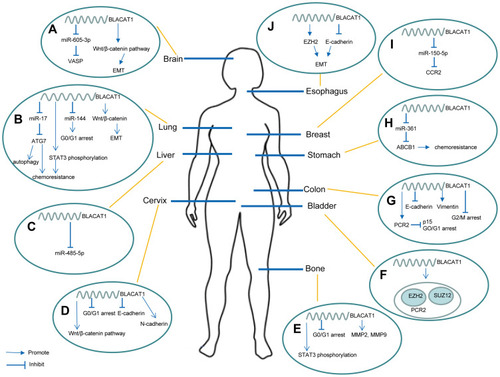Figures & data
Table 1 Functional Characterization of BLACAT1 in Various Cancers
Table 2 Clinical Significance of BLACAT1 in Various Cancers
Figure 1 Overview of the regulatory mechanisms of BLACAT1 on proliferation, invasion, metastasis, tumor cell cycle control, apoptosis, autophagy, and chemoresistance in multiple human cancers. (A) BLACAT1 binds to miR-605-3p to upregulate VASP, and it also promotes EMT by activating Wnt/β-catenin pathway. (B) BLACAT1 regulates ATG7 by competitively binding to miR-17, and ATG7 overexpression leads to autophagy and chemoresistance; BLACAT1 also facilitates chemoresistance by modulating STAT3 phosphorylation; in addition, BLACAT1 regulates cell cycle by sponging miR-144 and promotes EMT by activating Wnt/β-catenin pathway. (C) BLACAT1 competes against miR-485-5p. (D) BLACAT1 activates Wnt/β-catenin pathway, reduces G0/G1 arrest, and upregulates N-cadherin and downregulates E-cadherin. (E) BLACAT1 facilitates the STAT3 phosphorylation, reduces G0/G1 arrest, and increases the expression of MMP2 and MMP9. (F) BLACAT1 physically associates with PRC2 components EZH2 and SUZ12. (G) BLACAT1 represses p15 by binding to PRC2 to regulate cell cycle. (H) BLACAT1 upregulates ABCB1 by competitively binding to miR-361 to promote chemoresistance. (I) BLACAT1 binds to miR-150-5p to regulate CCR2. (J) BLACAT1 regulates EZH2 and represses E-cadherin to facilitate EMT.

